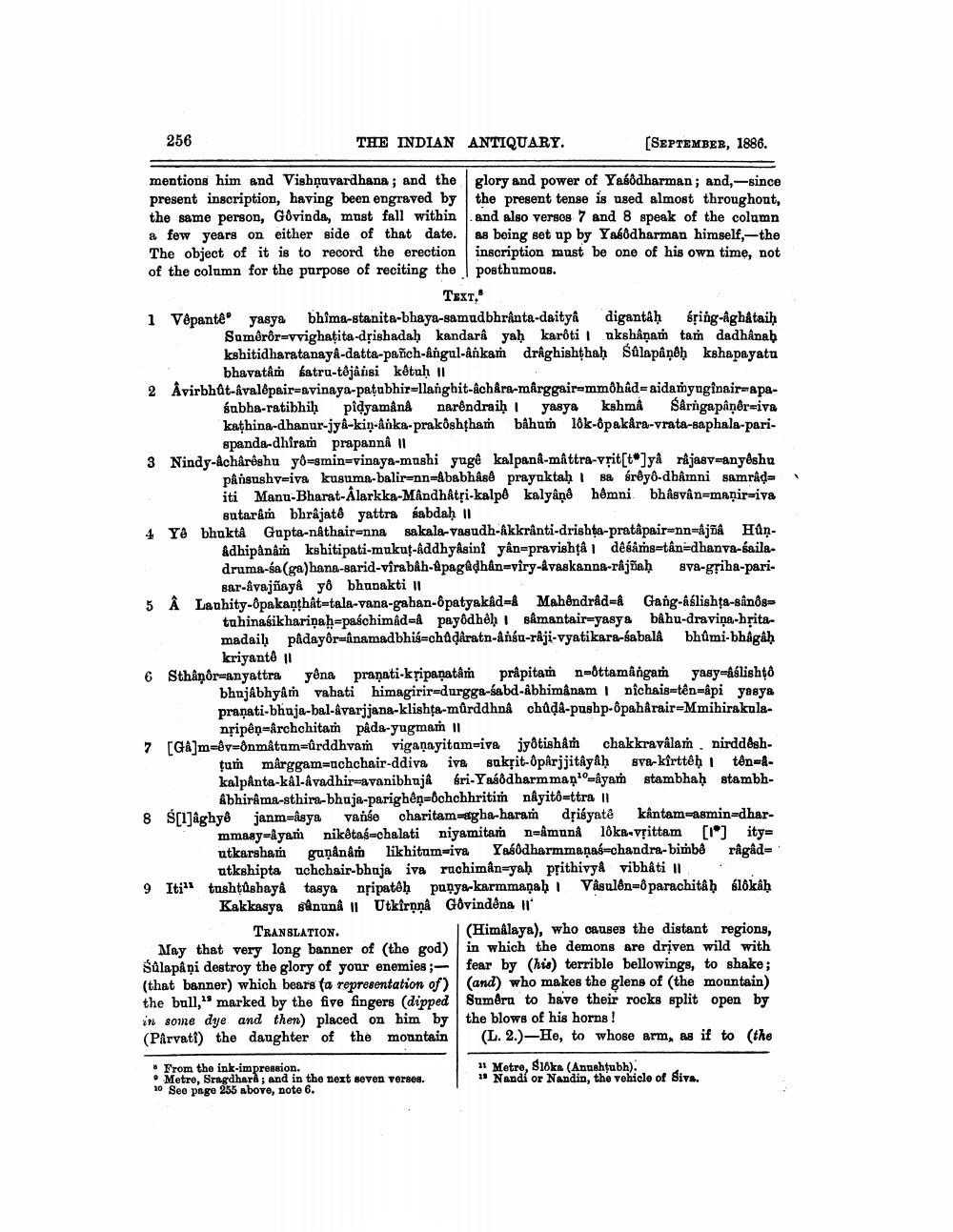________________
256
THE INDIAN ANTIQUARY.
[SEPTEMBER, 1886.
mentions him and Vishnuvardhana ; and the glory and power of Yaðdharman; and, --since present inscription, having been engraved by the present tense is used almost throughout, the same person, Govinda, must fall within and also versos 7 and 8 speak of the column a few years on either side of that date. as being set up by Yabodharman himself,-the The object of it is to record the erection inscription must be one of his own time, not of the column for the purpose of reciting the posthumous.
TEXT, 1 Vêpantê yasya bhima-stanita-bhaya-samadbhranta-daitya digantaḥ śping-aghataih
Sumôror-yvighatita-drishadah kandara yah karoti ukshana tam dadhanab kshitidharatanaya-datta-pañch-angul-ankam draghishthaḥ Sûlapaņôh kshapayatu
bhavatar katru-tâjâisi kôtuhl 2 Åvirbhût-kvalêpair=avinaya-patabhirullanghit-achâra-marggair-mmôhâd=aidamynginair-apa
subha-ratibhiḥ pidyamânâ narendraiḥ yasya kshmå Śârngapaņêreiva kathina-dhanur-jyâ-kinanka-prakôshtham bâhun 18k-Ôpakâra-vrata-saphala-pari
spanda-dhiram prapann 11 3 Nindy-Achårôghu y-smin=vinaya-mushi yugé kalpana-måttra-vșit[t]yå rijasyranyéshu
pånsushymiva kusuma-balirenn-Ababhâsê prayuktaḥ sa sr@y0-dhainni samråd iti Manu-Bharat-Alarkka-Mândhátri-kalpê kalyaņê hêmni bhâsvân=maņir=iva
sutaran bbrajatê yattra sabdah II 4 Y& bhukta Gupta-nAthair=nna sakala-vasudh-akkrânti-drishta-pratâpairænn-Ajmik Hûn.
Adhipanari kshitipati-mukut-Addhyâsini yân=pravishțâ 1 désâms=tân=dhanva-sailadruma-sa(ga)hana-sarid-virabdh-Apagadhån=viry-Avaskanna-rajñaḥ sva-gpiha-pari
sar-Avajñaya yo bhunakti !! 5 Å Lauhity-Opakanhat-tala-vana-gahan-patyakâd=& Mahồndråd=& Gang-aslishţa-sanog
tuhinasikharinah-paschimad=& payôdhëh! sømantair=yasya bhu-dravinn-britamadaib padayőrwanamadbhis-chaqaratn-ansu-raji-vyatikara-babal bhumi-bhagah
kriyanto 11 6 Sthânôr-anyattra yôna pranati-kļipanatâm pripitam noottamangam yasy-Aslisht
bhujAbhyam vabati himagirir-durgga-sabd-Abhimanam nichais-ten-Api yosya pranati-bhuja-bal-Avarjjana-klishţa-murddhna chada-pushp-OpahArair-Mmihirakula
nfipên=&rchohitam pâda-yugma l 7 [GA]m-dy=Önmatum=urddhva viganayitam-iva jyotishậm chakkravalan, nirddésh
tum marggam-achchair-ddiva iva suksit-Opárjjitâyâḥ sva-kirttéh tén-AkalpAnta-kAl-Avadhir-avanibhajâ sri-Yasodharmmaņ"'ayam stambhah stambh
Abhirama-sthira-bhuja-parighêņ=ôchchhritim nâyitó-ttra 11 8 S[ujaghyê janm=isya vanse charitam-agha-haram drifyatê kantam-amin-dhar
mmaay-Ayam niktas-chalati niyamitan n=&muna 10ka-vrittam [1] ityutkarsham guņånam likhitum=iva Yaśôdharmmaņas-chandra-bimbê rågade
utkshipta uchchair-bhaja iva rachimån=yaḥ prithivy vibháti 11 9 Iti" tushtůshaya tasya npipatêh punya-karmmaņah! Vâsulên=ô parachitaḥ slokaḥ
Kakkasya sanung || Utkirộna Govindêna ii TRANSLATION.
(Himalaya), who causes the distant regions, May that very long banner of (the god) in which the demons are driven wild with Salapâ ni destroy the glory of your enemies ;- fear by (his) terrible bellowings, to shake; (that banner) which bears fa representation of) (and) who makes the glens of the mountain) the bull,"marked by the five fingers (dipped Sumeru to have their rocks split open by in some dye and then) placed on him by the blows of his horns! (Parvati) the daughter of the monntain (L. 2.)-He, to whose arm, as if to (the
• From the ink-impression. • Metre, Sragdhard; and in the next seven verses. 10 See page 255 above, note 6.
11 Metre, $ióka (Anushubh).
Nandi or Nandin, the vehicle of Siva.




